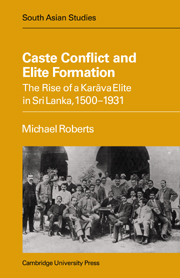Book contents
- Frontmatter
- Contents
- List of figures, chart and maps
- List of tables
- Preface
- Glossary
- List of abbreviations
- Map 1 The Kingdoms of Kotte and Kandy
- Map 2 Some physical features and place names
- Map 3 Present administrative divisions and the contemporary migration patterns of fishermen
- Map 4 The coastal waters of Sri Lanka and southeastern India
- 1 Introduction
- 2 The Karāva in the past
- 3 Caste among the Sinhalese
- 4 Economic opportunities and social relations, 1500s–1790s
- 5 The British period: the economic advances of a Karāva elite
- 6 Social competition, caste conflict and manifestations of Karāva power
- 7 Casteism in South Asian politics during British times: emergent cultural typifications or elite fictions?
- 8 Causal factors in the moulding of Karāva entrepreneurship and the emergence of a Karāva elite
- 9 Concluding remarks
- Tables
- Appendix 1 Problems and cautionary notes concerning the information derived from the plantation directories in the sequential series known as Ferguson's Ceylon Directory
- Appendix 2 A contemporary newspaper account of the reception provided for a Karāva notable on his receiving the title of ‘Mudaliyar of the Governor's Gate’ in 1853
- Appendix 3 A list of caste pamphlets and caste literature in chronological order, 1864–1930
- Select bibliography
- Index
4 - Economic opportunities and social relations, 1500s–1790s
Published online by Cambridge University Press: 30 October 2009
- Frontmatter
- Contents
- List of figures, chart and maps
- List of tables
- Preface
- Glossary
- List of abbreviations
- Map 1 The Kingdoms of Kotte and Kandy
- Map 2 Some physical features and place names
- Map 3 Present administrative divisions and the contemporary migration patterns of fishermen
- Map 4 The coastal waters of Sri Lanka and southeastern India
- 1 Introduction
- 2 The Karāva in the past
- 3 Caste among the Sinhalese
- 4 Economic opportunities and social relations, 1500s–1790s
- 5 The British period: the economic advances of a Karāva elite
- 6 Social competition, caste conflict and manifestations of Karāva power
- 7 Casteism in South Asian politics during British times: emergent cultural typifications or elite fictions?
- 8 Causal factors in the moulding of Karāva entrepreneurship and the emergence of a Karāva elite
- 9 Concluding remarks
- Tables
- Appendix 1 Problems and cautionary notes concerning the information derived from the plantation directories in the sequential series known as Ferguson's Ceylon Directory
- Appendix 2 A contemporary newspaper account of the reception provided for a Karāva notable on his receiving the title of ‘Mudaliyar of the Governor's Gate’ in 1853
- Appendix 3 A list of caste pamphlets and caste literature in chronological order, 1864–1930
- Select bibliography
- Index
Summary
In this chapter the information on the diversification of occupations that was presented in the previous chapter will be intermeshed with other data to outline the opportunities which residents in the Maritime Provinces had to extend their economic resources. Some of the consequences for social relations that seem to have accompanied these developments will then be traced. Throughout, the focus will largely be on the regions in the Maritime Provinces where Sinhalese-speakers have been in a majority, that is, the Low-Country Sinhalese districts.
Commerce and opportunities for economic advancement
From well before the advent of the European powers, it is known, Sri Lanka occupied an important place in the inter Asian trade, particularly in commodity exchange along the extended coastline of the Indian sub-continent (see maps 4 and 5). The island provided such commodities as arecanuts, cinnamon, elephants, gems, timber, coconuts, coconut oil, cordage, coir and tobacco. At such ports as Mannar, Kalpitiya and Jaffna in the Tamil areas, at Kottiyar and Batticaloa on the eastern coast and at Puttalam, Chilaw, Kammala, Negombo, Mutwal, Colombo, Panadura, Kalutara, Maggona, Beruwala, Alutgama, Welitara, Gintota, Galle, Weligama and Matara along the southwestern coast, these items were exchanged for rice, spices, dried fish, cloth, opium and other imports.
It follows that these products had to circulate within the island and that the export products had to reach the ports. In addition, one has to take note of the internal trade, including that which occurred along the island coastline – for the sea was by far the best medium for bulk transport when the monsoon was not at its height.
- Type
- Chapter
- Information
- Caste Conflict Elite Formation , pp. 75 - 97Publisher: Cambridge University PressPrint publication year: 1982



